Mesopotamian Military Expertise: The Age-Old Reimagining of Combat
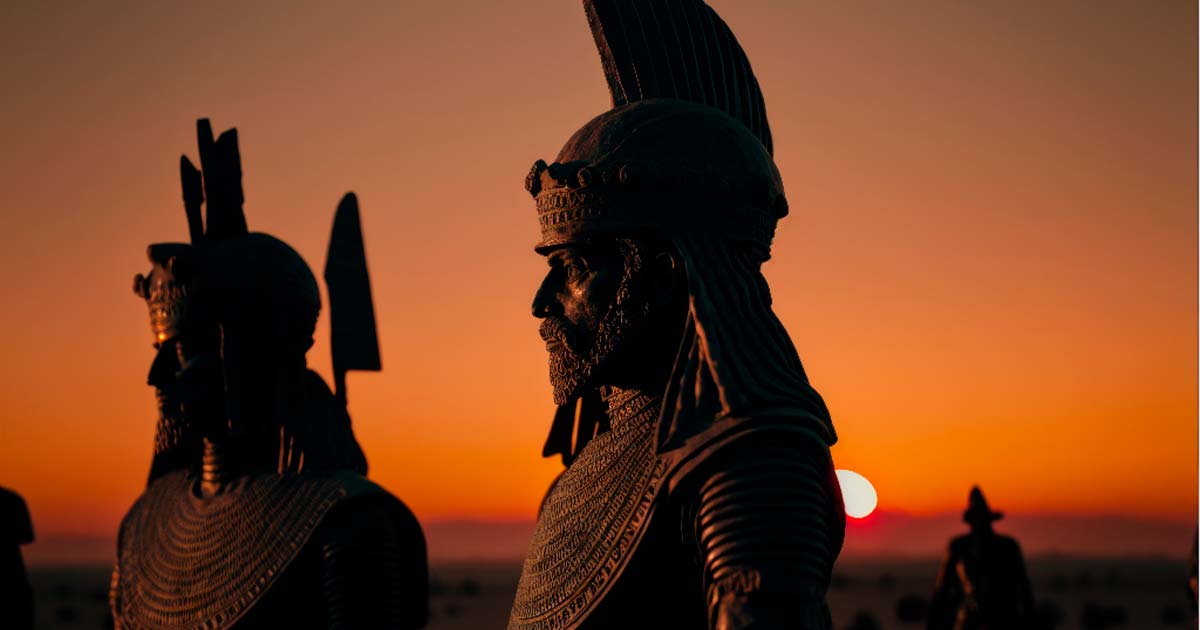
Creating a great empire in ancient times was no simple task, and it usually involved a lot of warfare. Ancient Mesopotamia, called by many the cradle of civilization, was also the cradle of organized warfare, of tactics and generals, of specialized weaponry and military doctrines. And it is with the help of all these things that it endured for many long centuries. But what exactly encompassed this ancient and rudimentary military? What techniques did they employ to subjugate their neighbors and enemies? Here are the foremost aspects of the history of the Mesopotamian military.
1. Chariot Warfare
Ancient Mesopotamian chariot warfare, emerging around 2000 BC, marked a transformative shift in military tactics, and was something truly innovative in the world. Chariots, two-wheeled horse-drawn vehicles, became iconic symbols of Mesopotamian power and innovation on the battlefield. Typically crewed by a skilled driver and an archer or spearman, chariots provided unparalleled speed, agility, and medium-range striking capabilities. The Mesopotamians, particularly the Akkadians and Assyrians, harnessed the prowess of chariotry to devastating effect. This seemingly simple asset became one of the most feared sights on an ancient battlefield.
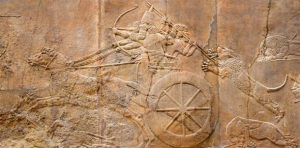
Assyrian relief of lions and warriors, ancient art of Mesopotamia. (scaliger/Adobe Stock)
Chariot units operated on the principle of hit-and-run tactics, exploiting their mobility to disrupt enemy formations. Armed with bows or spears, charioteers unleashed volleys of projectiles while maneuvering with remarkable dexterity. The psychological impact of chariot charges, coupled with their ability to traverse varied terrains, granted Mesopotamian armies a strategic advantage. Chariot Warfare influenced the dynamics of conflicts in the region, emphasizing rapid strikes and strategic maneuvering, ultimately contributing to the military dominance of Mesopotamian city-states during this era. The legacy of Mesopotamian Chariot Warfare endured, shaping subsequent military doctrines and leaving an indelible mark on the annals of ancient warfare.
Five Surprising Ways Mesopotamia Shaped the World
Lagash, the Lost City of Mesopotamia
2. Siege Warfare and Techniques
Ancient Mesopotamian siege warfare and related techniques showcased remarkable strategic ingenuity as city-states fortified their urban centers. Evolving over centuries, Mesopotamian military engineers devised sophisticated methods to breach formidable city walls. Siege towers, towering structures with mobile platforms, allowed troops to approach and scale defensive walls, while battering rams were employed to break through wooden gates. Mesopotamian armies, adept in siege craft, meticulously undermined walls, destabilizing foundations to facilitate breaches. And considering that the power of Mesopotamian city-states was centered on fortified settlements, the evolution of siege warfare was almost natural.
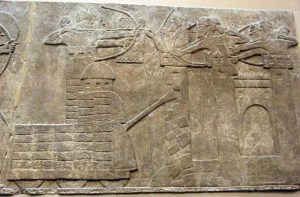
Assyrian attack on a town with archers and a wheeled battering ram. Neo-Assyrian relief, North-West Palace of Nimrud, 865–860 BC. (Public Domain)
“More than anything else, the Assyrian army excelled at siege warfare and was probably the first force to carry a separate corps of engineers (…) Assault was their principal tactic against the heavily fortified cities of the Near East. They developed a great variety of methods for breaching enemy walls: sappers were employed to undermine walls or to light fires underneath wooden gates, and ramps were thrown up to allow men to go over the ramparts or to attempt a breach on the upper section of wall where it was the least thick. Mobile ladders allowed attackers to cross moats and quickly assault any point in defenses. These operations were covered by masses of archers, who were the core of the infantry. But the pride of the Assyrian siege train was their engines. These were multistoried wooden towers with four wheels and a turret on top and one, or at times two, battering rams at the base.”
Psychological warfare also played a significant role, with besiegers aiming to demoralize defenders through various means such as hurling insults or displaying the remains of conquered enemies. Starvation tactics involved blockading cities, cutting off supply routes, and waiting for dwindling resources to force capitulation. Mesopotamian military minds demonstrated versatility, adapting siege techniques to diverse terrains and city layouts. For such an ancient historic period, the level of attention to detail in siege planning is almost stunning.
The success of siege warfare relied on the coordination of various specialized units, emphasizing the importance of engineers, infantry, and archers. These were no mobs of soldiers surrounding a fort – this was something much more complex. The enduring legacy of Mesopotamian siege warfare lies not only in its tangible impact on fortified structures but also in the strategic lessons it imparted, influencing subsequent military campaigns throughout the ancient world. It also directly influenced the evolution of fortified cities in the region.
3. Mesopotamian Military Organization and Rank
The military organization and ranks in the armies of Mesopotamia reflected the dynamic and multifaceted nature of a city-state and its defense structures. The composition of armies varied, incorporating a mix of conscripts and “professional”, trained soldiers. Organized into units based on skills and weaponry, the military hierarchy accommodated flexibility to adapt to diverse tactical scenarios. On the battlefield, these diverse units could be shifted to meet any particular threat.
Leadership roles encompassed the paramount Lugal, or king, who often assumed a direct role in military affairs, personally leading campaigns to enhance legitimacy and power, and to achieve fame as well. Military governors oversaw regional defense, while specialized officers managed distinct aspects of the armed forces. The hierarchical structure extended to the soldiers, categorized based on expertise and equipment. This was a proper army, complex and advanced.
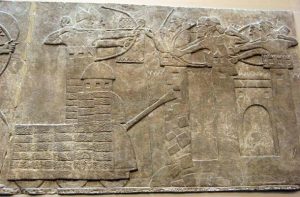
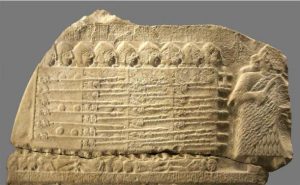
The Scene from the Stele of the Vultures, created to commemorate the victory of Lagash over Umma c. 2600 BC. (Eric Gaba/CC BY-SA)
Soldiers underwent training in various weapons that were common at this time, contributing to the versatility of Mesopotamian armies. The military organization facilitated efficient coordination in battles and campaigns, fostering adaptability in response to evolving threats. Mesopotamian city-states recognized the paramount importance of a well-organized and disciplined military structure, ensuring the defense and expansion of their territories through a balanced blend of professional soldiers and civic duty-driven conscripts. This intricate system of military organization played a pivotal role in shaping the success and resilience of Mesopotamian city-states in the volatile landscape of ancient warfare. Without their strong armies, these cities would have never endured for so long.
4. Role of the Lugal
The Lugal, or king, had a special role in ancient Mesopotamia and held paramount significance in both political and military spheres. As the highest authority, the Lugal was not only the political ruler seated on his throne – he was also a central figure in military affairs. Lugals often personally led their armies into battle, exemplifying their commitment to the defense and expansion of the city-state. Military success served as a powerful tool for legitimizing and consolidating the ruler’s authority. Winning battles equaled power, wealth, and a long reign. Losing them equaled absolute defeat.
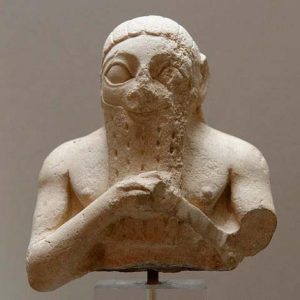
Lugal-kisal-si, king of Uruk. Limestone, Early Dynastic III. From Adab. (© Marie-Lan Nguyen /Wikimedia Commons /CC-BY 2.5)
The Lugal’s involvement in warfare extended beyond symbolic gestures or appearance on the battlefield, instead encompassing strategic decision-making, battle tactics, and the overall direction of military campaigns. The Lugal’s martial prowess became a source of inspiration for the troops, instilling confidence in the citizenry. Success on the battlefield not only solidified the ruler’s position but also enhanced the prestige and power of the city-state. The Lugal’s dual role as a political and military leader exemplified the interconnectedness of governance and defense in ancient Mesopotamia, showcasing the ruler’s pivotal role in shaping the fate of the city-state through both diplomatic and martial endeavors. All this means not just anybody could be King in this ancient era. The person would have to be truly made for it, knowing how to rule, wage war, and subjugate enemies.
5. Weaponry and Armor Evolution
The evolution of weaponry and armor in Mesopotamia marked a significant technological progression in military capabilities. Early Mesopotamian soldiers, as early as 3000 BC, primarily used simple weapons such as slings, spears, and maces. However, the advent of bronze metallurgy around 2500 BC revolutionized warfare, leading to the development of more advanced weapons and armor.
Bronze weapons, including swords, axes, and daggers, offered superior cutting capabilities and durability compared to their stone or copper counterparts. This innovation significantly increased the lethality of Mesopotamian armies. Concurrently, advancements in armor became crucial for soldiers’ protection. Bronze helmets, shields, and body armor provided enhanced defense against enemy attacks. This was the arrival of true ancient warfare.
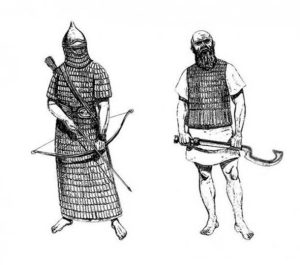
A historical illustration of Mesopotamian military warrior wearing long and short leather armor. (Lunstream /Adobe Stock)
Over time, almost a millennium later, Mesopotamian craftsmen refined their metallurgical techniques, incorporating iron into weaponry and armor around 1200 BC. This transition to iron further strengthened military capabilities, as iron weapons were more durable and could be produced in larger quantities. The continuous evolution of weaponry and armor in ancient Mesopotamia demonstrated the region’s adaptability and commitment to staying at the forefront of military technology, influencing subsequent developments in ancient warfare. It also showed that warfare was always the number one priority.
6. Use of Cavalry
The ancient Mesopotamian use of cavalry marked a pivotal development in military strategy, introducing unprecedented speed and flexibility to the battlefield. Beginning around 2000 BC, and truly thriving around 1000 BC, Mesopotamian armies incorporated both light and heavy cavalry into their ranks. Light cavalry, often armed with bows or javelins, excelled in reconnaissance, harassment of enemy formations, and engaging in hit-and-run tactics. Their agility allowed for swift maneuvers and the exploitation of terrain, making them invaluable in diverse combat scenarios. Of course, good horses were paramount for this, and the Mesopotamians bred quality horses suited for these roles.

From the Exhibition: I am Ashurbanipal king of the world, king of Assyria, British Museum (Carole Raddato/CC BY-SA 2.0)
Heavy cavalry, on the other hand, played a crucial role in charging enemy lines and engaging in direct combat. Equipped with more substantial armor and weapons, heavy cavalry provided a formidable striking force capable of breaking through enemy formations. The combination of infantry and cavalry created a versatile and dynamic military force, demonstrating the strategic acumen of Mesopotamian commanders.
The use of cavalry in Mesopotamian warfare reflected a nuanced understanding of the advantages offered by different types of mounted troops. This innovation influenced subsequent military doctrines, shaping the role of cavalry in ancient warfare for centuries to come.
7. Logistics and Supply Chains
Logistics and supply chains were critical elements of military success, showcasing the region’s advanced organizational capabilities. The Tigris and Euphrates rivers served as vital conduits for the movement of troops and supplies, facilitating strategic deployments and reinforcing key positions. Mesopotamian armies maintained extensive granaries strategically positioned to stockpile grain and other provisions, ensuring sustained campaigns.
Effective logistics involved the coordination of transportation, storage, and distribution, emphasizing the need for well-maintained roads and river networks. The Mesopotamians demonstrated remarkable adaptability in managing supply chains over diverse terrains, from the fertile river valleys to arid regions.
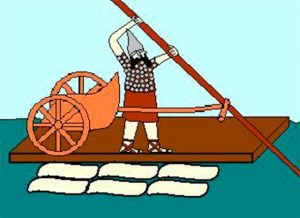
Illustration of an Assyrian using inflated sheep skins to transport chariots across the Euphrates (or Tigris) (Public Domain)
River transport not only expedited the movement of troops but also facilitated the delivery of essential goods to the front lines. Strategic depots ensured that armies remained well-fed and equipped during extended military operations, contributing to the overall effectiveness of Mesopotamian campaigns. The sophisticated logistics and supply chain management of ancient Mesopotamia played a pivotal role in sustaining military endeavors, showcasing a level of organizational sophistication that was crucial for maintaining dominance in the volatile landscape of ancient warfare.
The Iron Army: Assyria – Deadly and Effective Siege Machine – Part II
The Spectacular War Helmet of Meskalamdug, the Powerful King of Kish
An Enduring Legacy of Ancient Warfare
In conclusion, the history of ancient Mesopotamian warfare is marked by innovation, adaptability, and true strategic brilliance. From the revolutionary chariot warfare that reshaped battlefield dynamics to the intricate siege techniques that fortified city-states, the military prowess of Mesopotamia left an incredible mark on the flow of ancient history. What is more, it shaped the history of civilizations that would come centuries later, firmly setting the foundations of warfare and dynamics between different civilizations – which were often rooted in warfare, conquest, subjugation, and brutal combat